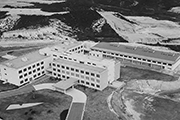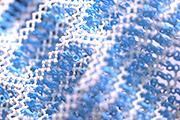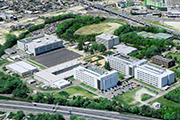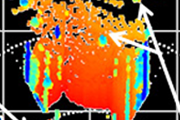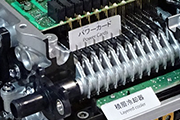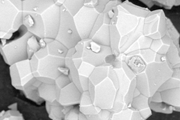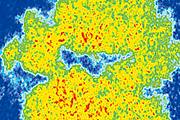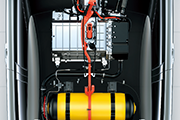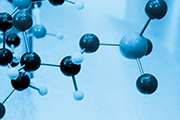Expanding Electrochemical Simulations with Machine-Learning Force Fields
Expanding Electrochemical Simulations with Machine-Learning Force Fields
A study conducted by Ryosuke Jinnouchi et al. was published in ACS Nano.
The properties of matters are governed by the interactions of their constituent particles. First-principles molecular dynamics (FPMD) is a leading approach for predicting the properties of unknown materials and discovering advanced materials. This method solves wave equations (e.g., the Dirac equation) that describe the behavior of particles, thereby enabling the computation of instantaneous interparticle interactions, which can then be used to simulate particle motion and material properties. However, FPMD is computationally expensive, limiting accessible scales to a few nanometers (hundreds of atoms) and hundreds of picoseconds.
In recent years, machine-learning force fields (MLFFs) have emerged as a powerful means of overcoming this limitation. An MLFF is a machine-learning model that is trained using large datasets of first-principles calculations to predict interparticle interactions. This enables rapid predictions with near-first-principles accuracy without solving the wave equations explicitly. Consequently, simulations can be applied to a wide range of systems, including gases, liquids, solids, interfaces, and organic, inorganic, and biomolecular materials, spanning spatial scales from a few to ~100 nanometers (10²–10¹¹ atoms) and temporal scales from hundreds of picoseconds to several microseconds. Owing to their orders-of-magnitude improvement in computational efficiency, MLFFs are becoming a core technology in materials informatics.
Building on roughly ten years of MLFF development at Toyota Central R&D Labs, this review article summarizes recent trends and future prospects in the field using electrochemistry as a representative example. These insights are expected to accelerate progress in materials science, including electrochemistry, and contribute to the realization of a sustainable energy society.
Notably, one of the MLFF technologies developed at our Labs and introduced in this review was recognized as a pioneering application of machine learning in condensed-matter physics. It is cited in the scientific background of the 2024 Nobel Prize in Physics, which was awarded to John J. Hopfield and Geoffrey E. Hinton[Click here for details (Japanese)] Ref5, Ref 12 .
Title: Machine Learning Force Fields in Electrochemistry: From Fundamentals to Applications
Atuthors: Jinnouchi, R., Minami, S.
Journal Name: ACS NANO
Published: June 18, 2025
https://doi.org/10.1021/acsnano.5c05553
Related Publications
1.Jinnouchi, R.; Miwa, K.; Karsai, F.; Kresse, G.; Asahi, R. On-the-Fly Active Learning of Interatomic Potentials for Large-Scale Atomistic Simulations. J. Phys. Chem. Lett. 2020, 11, 6946– 6955, DOI: 10.1021/acs.jpclett.0c01061
2.Jinnouchi, R.; Kodama, K.; Morimoto, Y. Electronic Structure Calculations on Electrolyte-Electrode Interfaces: Successes and Limitations. Curr. Opin. Electrochem. 2018, 8, 103– 109, DOI: 10.1016/j.coelec.2018.03.024
3.Jinnouchi, R. Grand-Canonical First Principles-Based Calculations of Electrochemical Reactions. J. Electrochem. Soc. 2024, 171, 096502 DOI: 10.1149/1945-7111/ad7326
4.Jinnouchi, R.; Karsai, F.; Kresse, G. On-the-Fly Machine Learning Force Field Generation: Application to Melting Points. Phys. Rev. B 2019, 100, 014105 DOI: 10.1103/PhysRevB.100.014105
5.Jinnouchi, R.; Lahnsteiner, J.; Karsai, F.; Kresse, G.; Bokdam, M. Phase Transitions of Hybrid Perovskites Simulated by Machine-Learning Force Fields Trained on the Fly with Bayesian Inference. Phys. Rev. Lett. 2019, 122, 225701 DOI: 10.1103/PhysRevLett.122.225701
6.Jinnouchi, R.; Karsai, F.; Kresse, G. Making Free-Energy Calculations Routine: Combining First Principles with Machine Learning. Phys. Rev. B 2020, 101, 060201 DOI: 10.1103/PhysRevB.101.060201
7.Verdi, C.; Karsai, F.; Liu, P.; Jinnouchi, R.; Kresse, G. Thermal Transport and Phase Transitions of Zirconia by on-the-Fly Machine-Learned Interatomic Potentials. npj Comput. Mater. 2021, 7, 156 DOI: 10.1038/s41524-021-00630-5
8.Jinnouchi, R.; Karsai, F.; Verdi, C.; Kresse, G. First-Principles Hydration Free Energies of Oxygenated Species at Water-Platinum Interfaces. J. Chem. Phys. 2021, 154, 094107 DOI: 10.1063/5.0036097
9.Jinnouchi, R. Molecular Dynamics Simulations of Proton Conducting Media Containing Phosphoric Acid. Phys. Chem. Chem. Phys. 2022, 24, 15522– 15531, DOI: 10.1039/D2CP00484D
10.Jinnouchi, R.; Minami, S.; Karsai, F.; Verdi, C.; Kresse, G. Proton Transport in Perfluorinated Ionomer Simulated by Machine-Learned Interatomic Potential. J. Phys. Chem. Lett. 2023, 14, 3581– 3588, DOI: 10.1021/acs.jpclett.3c00293
11.Minami, S.; Jinnouchi, R. Accelerating Anhydrous Proton Conduction via Anion Rotation and Hydrogen Bond Recombination: a Machine-Learning Molecular Dynamics. J. Mater. Chem. A 2023, 11, 16104– 16114, DOI: 10.1039/D3TA03164K
12.de Hijes, P. M.; Dellago, C.; Jinnouchi, R.; Schmiedmayer, B.; Kresse, G. Comparing Machine Learning Potentials for Water: Kernel-Based Regression and Behler-Parrinello Neural Networks. J. Chem. Phys. 2024, 160, 114107 DOI: 10.1063/5.0197105
13.Minami, S.; Kin, M.; Takahashi, K.; Sato, T.; Jinnouchi, R. Impact of Local Water Uptake on Proton Conduction in Covalent Organic Framework Revealed by Machine-Learning Potentials. Chem. Mater. 2024, 36, 9535– 9546, DOI: 10.1021/acs.chemmater.4c01351
14.Jinnouchi, R. Machine-Learning Surrogate Models for Particle Insertions and Element Substitutions. J. Chem. Phys. 2024, 161, 194110 DOI: 10.1063/5.0240275
15.Jinnouchi, R.; Karsai, F.; Kresse, G. Absolute Standard Hydrogen Electrode Potential and Redox Potentials of Atoms and Molecules: Machine Learning Aided First Principles Calculations. Chem. Sci. 2025, 16, 2335– 2343, DOI: 10.1039/D4SC03378G
16.Jinnouchi, R.; Minami, S. The Melamine-Driven Solvation Effect Promotes Oxygen Reduction on a Platinum Catalyst: Machine Learning-Aided Free Energy Calculations. J. Phys. Chem. Lett. 2025, 16, 265– 273, DOI: 10.1021/acs.jpclett.4c03437
17.Jinnouchi, R.; Karsai, F.; Verdi, C.; Asahi, R.; Kresse, G. Descriptors Representing Two- and Three-Body Atomic Distributions and Their Effects on the Accuracy of Machine-Learned Inter-Atomic Potentials. J. Chem. Phys. 2020, 152, 234102 DOI: 10.1063/5.0009491
18.Jinnouchi, R.; Karsai, F.; Kresse, G. Machine Learning-Aided First-Principles Calculations of Redox Potentials. npj Comput. Mater. 2024, 10, 107 DOI: 10.1038/s41524-024-01295-6
19.Jinnouchi, R.; Anderson, A. B. Aqueous and Surface Redox Potentials from Self-Consistently Determined Gibbs Energies. J. Phys. Chem. C 2008, 112, 8747– 8750, DOI: 10.1021/jp802627s
20.Jinnouchi, R.; Hatanaka, T.; Morimoto, Y.; Osawa, M. First Principles Study of Sulfuric Acid Anion Adsorption on a Pt(111) Electrode. Phys. Chem. Chem. Phys. 2012, 14, 3208– 3218, DOI: 10.1039/c2cp23172g
21.Nagai, T.; Kikkawa, N.; Jinnouchi, R.; Kimura, M.; Okazaki, S. Machine Learning Model to Predict Free-Energy Landscape and Position-Dependent Diffusion Constant to Extend the Scale of Dynamic Monte Carlo Simulations. J. Chem. Theory Comput. 2025, 21, 2598– 2611, DOI: 10.1021/acs.jctc.4c01552
22.Jinnouchi, R.; Asahi, R. Predicting Catalytic Activity of Nanoparticles by a DFT-Aided Machine-Learning Algorithm. J. Phys. Chem. Lett. 2017, 8, 4279– 4283, DOI: 10.1021/acs.jpclett.7b02010
23.Jinnouchi, R.; Hirata, H.; Asahi, R. Extrapolating Energetics on Clusters and Single-Crystal Surfaces to Nanoparticles by Machine-Learning Scheme. J. Phys. Chem. C 2017, 121, 26397– 26405, DOI: 10.1021/acs.jpcc.7b08686
















